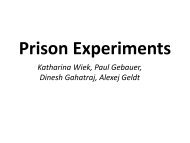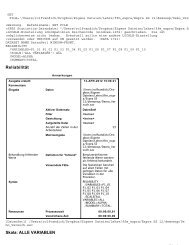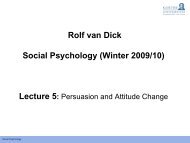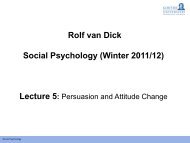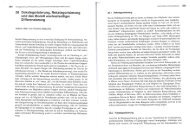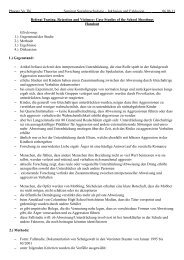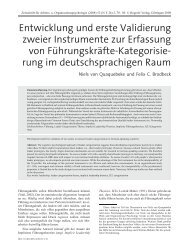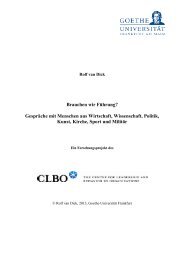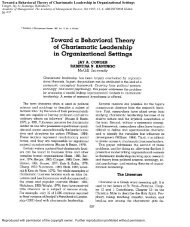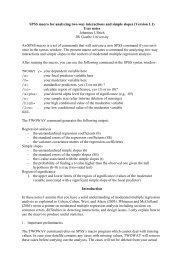Social Identity Theory and Self-categorization Theory: A Historical ...
Social Identity Theory and Self-categorization Theory: A Historical ...
Social Identity Theory and Self-categorization Theory: A Historical ...
Create successful ePaper yourself
Turn your PDF publications into a flip-book with our unique Google optimized e-Paper software.
<strong>Social</strong> <strong>and</strong> Personality Psychology Compass 2/1 (2008): 204–222, 10.1111/j.1751-9004.2007.00066.x<br />
<strong>Social</strong> <strong>Identity</strong> <strong>Theory</strong> <strong>and</strong> <strong>Self</strong>-<strong>categorization</strong><br />
<strong>Theory</strong>: A <strong>Historical</strong> Review<br />
Matthew J. Hornsey*<br />
University of Queensl<strong>and</strong><br />
Abstract<br />
The social identity approach (comprising social identity theory <strong>and</strong> self-<strong>categorization</strong><br />
theory) is a highly influential theory of group processes <strong>and</strong> intergroup relations,<br />
having redefined how we think about numerous group-mediated phenomena.<br />
Since its emergence in the early 1970s, the social identity approach has been<br />
elaborated, re-interpreted, <strong>and</strong> occasionally misinterpreted. The goal of this paper<br />
is to provide a critical, historical review of how thinking <strong>and</strong> research within the<br />
social identity approach has evolved. The core principles of the theories are<br />
reviewed <strong>and</strong> discussed, <strong>and</strong> their effect on the field assessed. Strengths <strong>and</strong> limitations<br />
of the approach are discussed, with an eye to future developments.<br />
After World War II, many social psychologists saw it as their brief to<br />
underst<strong>and</strong> the psychology of intergroup relations: How could we explain<br />
the psychological forces that culminated in the Holocaust, among other<br />
horrors? Early attempts to explain this relied heavily on the notion that<br />
prejudice was the irrational manifestation of some force that resided in the<br />
individual, whether that be frustration (Dollard, Doob, Miller, Mowrer, &<br />
Sears, 1939) or an unresolved conflict with authoritarian parents (Adorno,<br />
Fenkel-Brunswik, Levinson, & Sanford, 1950). This reflected a broader<br />
tendency within social psychology to view intergroup relations as intrapsychic<br />
or interpersonal processes writ large. Indeed, for much of the post-war<br />
period leading into the 1970s, the ‘group’ was treated as something of a<br />
label of convenience for what happened when interpersonal processes<br />
were aggregated.<br />
During the late 1960s <strong>and</strong> early 1970s, there was robust debate about<br />
where social psychological theory <strong>and</strong> research had taken us (the so-called<br />
‘crisis of confidence’ in social psychology; Elms, 1975), <strong>and</strong> nowhere was<br />
this crisis more evident than in discussions of group processes <strong>and</strong> intergroup<br />
relations. Many commentators criticized the field for its tendency<br />
to overlook ‘big picture’ constructs such as language, history, <strong>and</strong> culture<br />
in favour of intrapsychic <strong>and</strong> interpersonal processes (see Hogg & Williams,<br />
2000, for a review). The theories that later became known as the social<br />
© 2008 The Author<br />
Journal Compilation © 2008 Blackwell Publishing Ltd
<strong>Social</strong> <strong>Identity</strong> <strong>Theory</strong> <strong>and</strong> <strong>Self</strong>-<strong>categorization</strong> <strong>Theory</strong> 205<br />
identity approach – social identity theory <strong>and</strong> self-<strong>categorization</strong> theory –<br />
were born in this era of crisis. What emerged was an ambitious <strong>and</strong><br />
far-reaching cluster of ideas that were pitched as an antidote to the overly<br />
individualistic <strong>and</strong> reductionist tendencies of existing theories of intergroup<br />
relations. Initially presented to the world in a series of books, chapters,<br />
<strong>and</strong> monographs intended largely for a European audience, the theories<br />
began to attract broader international attention in the 1980s <strong>and</strong> 1990s. 1<br />
The social identity approach is now one of the most influential theories<br />
of group processes <strong>and</strong> intergroup relations worldwide, having redefined<br />
how we think about numerous group-mediated phenomena <strong>and</strong> having<br />
extended its reach well outside the confines of social psychology. 2<br />
Of course, in this time, the theory has evolved <strong>and</strong> been refined, but<br />
has also gone down the occasional theoretical cul-de-sac. The faster a<br />
theory grows in terms of its effect <strong>and</strong> reach, the greater the capacity for<br />
confusion <strong>and</strong> misinterpretation. At times, it helps to take stock <strong>and</strong> to<br />
review where the theory has been, how it has changed, <strong>and</strong> where it is<br />
heading. This is the goal of the current paper. In tracking the history of<br />
the social identity approach, I will briefly review its key elements. It is<br />
hoped that this will serve as a platform from which interested readers can<br />
pursue more detailed <strong>and</strong> nuanced descriptions of the theories (Hogg &<br />
Abrams, 1988; Tajfel, 1978; Tajfel & Turner, 1979; Turner, Hogg, Oakes,<br />
Reicher, & Wetherell, 1987).<br />
<strong>Social</strong> <strong>Identity</strong> <strong>Theory</strong><br />
Given social identity theory’s credentials as a theory with a strong focus<br />
on how the social context affects intergroup relations, it seems paradoxical<br />
that the ideas were framed by an experimental paradigm in which context<br />
was stripped away altogether: the ‘minimal group paradigm’. Henri Tajfel<br />
<strong>and</strong> colleagues published a series of studies in the early 1970s in which<br />
participants were allocated into groups on the basis of meaningless <strong>and</strong><br />
arbitrary criteria. In one experiment (Tajfel, Billig, Bundy, & Flament, 1971),<br />
participants were categorized as ‘overestimators’ or ‘underestimators’,<br />
ostensibly on the basis of their estimates of the numbers of dots on a page<br />
(in reality all participants were allocated to the same group). In another<br />
experiment, they were allocated into groups on the basis of the flip of a<br />
coin (Billig & Tajfel, 1973). After having been told their group membership,<br />
participants then had to allocate points to members of their own group<br />
(the ‘ingroup’) <strong>and</strong> to members of the other group (the ‘outgroup’).<br />
From the perspective of a participant, this is an absurd task. The groups<br />
had no content, in the sense that they were based on trivial criteria. There<br />
was no interaction among group members, <strong>and</strong> in fact, participants did<br />
not know who else within the session was in their group. The groups had<br />
no history <strong>and</strong> no future outside the laboratory. Furthermore, the participants<br />
could not benefit or lose in any way from their point allocation strategy.<br />
© 2008 The Author <strong>Social</strong> <strong>and</strong> Personality Psychology Compass 2/1 (2008): 204–222, 10.1111/j.1751-9004.2007.00066.x<br />
Journal Compilation © 2008 Blackwell Publishing Ltd
206 <strong>Social</strong> <strong>Identity</strong> <strong>Theory</strong> <strong>and</strong> <strong>Self</strong>-<strong>categorization</strong> <strong>Theory</strong><br />
Sometimes, the points carried value (in terms of being able to be traded<br />
for money), but participants were explicitly told that they personally could<br />
not benefit from their own point allocation strategy. In other experiments,<br />
the points did not carry value at all (Turner, 1978).<br />
Faced with this curious dilemma, one might expect the points allocation<br />
to be either r<strong>and</strong>om, or to be made on the basis of a strategy of fairness<br />
(equal numbers of points to members of each group). But this was not<br />
what was found. Instead, participants tended to give more points to members<br />
of their own group than to members of the outgroup. In fact, there was<br />
some evidence that participants were prepared to give relatively few points<br />
to either group if it allowed them to maximize the extent to which they<br />
favored their ingroup. Although stripped of history <strong>and</strong> context, the<br />
experiments were not psychologically empty because participants were<br />
obeying a predictable pattern of responding, <strong>and</strong> one that was difficult to<br />
explain according to traditional theories of intergroup relations. Tajfel et<br />
al. (1971) initially argued that the participants were obeying a norm of<br />
competitive group behaviour. But where did this norm come from? Why<br />
competition, <strong>and</strong> not fairness or some other strategy? The answers to<br />
these questions were later formalized in social identity theory (SIT; Tajfel,<br />
1978; Tajfel & Turner, 1979). 3<br />
In articulating the theory, Henri Tajfel (in collaboration with his graduate<br />
student John Turner) argued that human interaction ranges on a spectrum<br />
from being purely interpersonal on the one h<strong>and</strong> to purely intergroup on<br />
the other. A purely interpersonal interaction (which Tajfel <strong>and</strong> Turner<br />
believed to be rare) involves people relating entirely as individuals, with<br />
no awareness of social categories. A purely intergroup interaction is one<br />
in which people relate entirely as representatives of their groups, <strong>and</strong><br />
where one’s idiosyncratic, individualizing qualities are overwhelmed by<br />
the salience of one’s group memberships. It was argued that sliding from<br />
the interpersonal to the intergroup end of the spectrum results in shifts in<br />
how people see themselves <strong>and</strong> each other.<br />
Drawing on his own social cognition work (Tajfel & Wilkes, 1963), Tajfel<br />
argued that the mere process of making salient ‘us <strong>and</strong> them’ distinctions<br />
changes the way people see each other. When category distinctions are<br />
salient, people perceptually enhance similarities within the group (‘we’re all<br />
much the same’) <strong>and</strong> enhance differences among the group (‘we’re different<br />
from them’). Categorization also changes the way people see themselves,<br />
in the sense that it activates a different level of one’s self-concept. At the<br />
interpersonal end of the spectrum, people’s self-concept will mostly comprise<br />
the attitudes, memories, behaviours, <strong>and</strong> emotions that define them as<br />
idiosyncratic individuals, distinct from other individuals (one’s ‘personal<br />
identity’). At the intergroup end of the spectrum, self-concept will mostly<br />
comprise one’s ‘social identity’, defined as those aspects of an individual’s<br />
self-image that derive from the social categories to which he/she belongs, as<br />
well as the emotional <strong>and</strong> evaluative consequences of this group membership.<br />
© 2008 The Author <strong>Social</strong> <strong>and</strong> Personality Psychology Compass 2/1 (2008): 204–222, 10.1111/j.1751-9004.2007.00066.x<br />
Journal Compilation © 2008 Blackwell Publishing Ltd
<strong>Social</strong> <strong>Identity</strong> <strong>Theory</strong> <strong>and</strong> <strong>Self</strong>-<strong>categorization</strong> <strong>Theory</strong> 207<br />
So why do people favor their own group relative to outgroups? Tajfel<br />
<strong>and</strong> Turner argued that the motivating principle underlying competitive<br />
intergroup behaviour was a desire for a positive <strong>and</strong> secure self-concept.<br />
If we are to accept that people are motivated to have a positive self-concept,<br />
it flows naturally that people should be motivated to think of their groups<br />
as good groups. Furthermore, drawing on Festinger’s writings on social<br />
comparison, it was argued that people evaluate their group with reference<br />
to relevant outgroups. Groups are not isl<strong>and</strong>s; they become psychologically<br />
real only when defined in comparison to other groups. Striving for a positive<br />
social identity, group members are motivated to think <strong>and</strong> act in ways that<br />
achieve or maintain a positive distinctiveness between one’s own group<br />
<strong>and</strong> relevant outgroups. It was this process that was presumed to underpin<br />
real world instances of intergroup differentiation <strong>and</strong> outgroup derogation.<br />
What happens, though, when people belong to a group that has relatively<br />
low status with respect to other groups? <strong>Social</strong> identity theorists spent a<br />
great deal of time outlining how a low status group member can claw<br />
back a positive social identity (Tajfel & Turner, 1979; Turner & Brown,<br />
1978; see also Hogg & Abrams, 1988). Options include leaving the group<br />
(either physically or psychologically), making downward intergroup<br />
comparisons that are more flattering to the ingroup, focusing only on<br />
dimensions that make the ingroup look relatively good, devaluing dimensions<br />
that reflect poorly on the ingroup, <strong>and</strong> engaging in social change to try<br />
to overturn the existing status hierarchy. Which strategy will be chosen<br />
will depend on a range of circumstances, including the extent to which<br />
the boundaries between the group were seen to be permeable, <strong>and</strong> the<br />
extent to which the status differences are perceived to be stable <strong>and</strong>/or<br />
legitimate. In sum, social identity theory was the first social psychological<br />
theory to acknowledge that groups occupy different levels of a hierarchy<br />
of status <strong>and</strong> power, <strong>and</strong> that intergroup behaviour is driven by people’s<br />
ability to be critical of, <strong>and</strong> to see alternatives to, the status quo. For<br />
Tajfel, social identity theory was at its heart a theory of social change. 4<br />
<strong>Self</strong>-<strong>categorization</strong> <strong>Theory</strong><br />
SIT argued that intergroup relations were governed by an interaction of<br />
cognitive, motivational, <strong>and</strong> socio-historical considerations. After Tajfel’s<br />
death in 1982, Turner <strong>and</strong> colleagues sought to elaborate <strong>and</strong> refine the<br />
cognitive element of the theory. In so doing, they aimed to move beyond<br />
the intergroup focus of SIT <strong>and</strong> to comment on intragroup processes as well.<br />
These elaborations were formalized in the book Rediscovering the social group:<br />
A self-<strong>categorization</strong> theory (Turner et al., 1987). The authors argued that the<br />
ideas in this book comprised a new <strong>and</strong> separate theory: self-<strong>categorization</strong><br />
theory (SCT). Having said that, SCT <strong>and</strong> SIT share most of the same<br />
assumptions <strong>and</strong> methods <strong>and</strong> emerge from the same ideological <strong>and</strong><br />
meta-theoretical perspective. In recognition of the similarities between the<br />
© 2008 The Author <strong>Social</strong> <strong>and</strong> Personality Psychology Compass 2/1 (2008): 204–222, 10.1111/j.1751-9004.2007.00066.x<br />
Journal Compilation © 2008 Blackwell Publishing Ltd
208 <strong>Social</strong> <strong>Identity</strong> <strong>Theory</strong> <strong>and</strong> <strong>Self</strong>-<strong>categorization</strong> <strong>Theory</strong><br />
theories, many people now refer to the ‘social identity perspective’ or the<br />
‘social identity approach’ to refer to both SIT <strong>and</strong> SCT, but with an<br />
acknowledgement that the two traditions have different foci <strong>and</strong> emphases.<br />
In SCT, Turner <strong>and</strong> colleagues returned to the <strong>categorization</strong> process<br />
that was considered fundamental to SIT. But rather than seeing interpersonal<br />
<strong>and</strong> intergroup dynamics as opposite ends of a bipolar spectrum, the<br />
proponents of SCT characterized identity as operating at different levels of<br />
inclusiveness. Turner <strong>and</strong> colleagues nominate three levels of self-<strong>categorization</strong><br />
that are important to the self-concept: the superordinate category of the<br />
self as human being (or human identity), the intermediate level of the self<br />
as a member of a social ingroup as defined against other groups of humans<br />
(social identity), <strong>and</strong> the subordinate level of personal self-<strong>categorization</strong>s<br />
based on interpersonal comparisons (personal identity). It was acknowledged<br />
that it is possible to uncover finer gradations of the intermediate level of<br />
abstraction, a possibility that has since been explored in the work on<br />
subgroup identities (Hornsey & Hogg, 2000). It is also assumed that there<br />
is a ‘functional antagonism’ between the levels of self-definition, such that<br />
as one level becomes more salient the other levels become less so.<br />
Given the large constellation of social identities to which people have<br />
access, what determines which particular identity will become the basis<br />
for <strong>categorization</strong> in any one context? According to SCT, <strong>categorization</strong><br />
(including self-<strong>categorization</strong>) occurs as a function of both accessibility<br />
<strong>and</strong> fit (Oakes, 1987; Oakes, Turner, & Haslam, 1991). Fit refers to the<br />
extent to which the social categories are perceived to reflect social reality;<br />
that is, the extent to which they are seen to be diagnostic of real-world<br />
differences. Individuals may perceive a high level of fit if the category<br />
distinction maximizes perceived intercategory differences <strong>and</strong> minimizes<br />
intracategory differences (comparative fit). This principle – referred to as the<br />
meta-contrast ratio – clearly owes an intellectual debt to classic work on<br />
<strong>categorization</strong>, in the sense that it argues that categories form in such a<br />
way that maximizes intraclass similarities <strong>and</strong> interclass differences. But<br />
SCT extends this argument by making it explicit that this process is<br />
dynamic, varying according to the context, <strong>and</strong> always defined relative to<br />
the perceiver. For example, a category distinction is also more likely to<br />
have high fit if social behavior <strong>and</strong> group membership are in line with<br />
stereotypical expectations (normative fit). Furthermore, categories are more<br />
or less likely to be a basis for self-definition if they are more or less<br />
accessible in the moment. Categories may be fleetingly accessible if they<br />
are primed in the situation, or they may be chronically accessible if<br />
frequently activated or if people are motivated to use them.<br />
One of the cornerstones of SCT is the notion of depersonalization.<br />
Proponents of SCT argue that people cognitively represent their social<br />
groups in terms of prototypes. When a category becomes salient, people<br />
come to see themselves <strong>and</strong> other category members less as individuals<br />
<strong>and</strong> more as interchangeable exemplars of the group prototype. The<br />
© 2008 The Author <strong>Social</strong> <strong>and</strong> Personality Psychology Compass 2/1 (2008): 204–222, 10.1111/j.1751-9004.2007.00066.x<br />
Journal Compilation © 2008 Blackwell Publishing Ltd
<strong>Social</strong> <strong>Identity</strong> <strong>Theory</strong> <strong>and</strong> <strong>Self</strong>-<strong>categorization</strong> <strong>Theory</strong> 209<br />
prototype is not an objective reality, but rather a subjective sense of the<br />
defining attributes of a social category that fluctuates according to context.<br />
The group identity not only describes what it is to be a group member,<br />
but also prescribes what kinds of attitudes, emotions <strong>and</strong> behaviours are<br />
appropriate in a given context. The notion of depersonalization was<br />
assumed to underpin a range of group processes such as cohesion, influence,<br />
conformity, <strong>and</strong> leadership. As such, SCT heralded a more thorough<br />
investigation of intragroup processes than had been possible within the<br />
rubric of SIT, which was preoccupied with intergroup relations.<br />
How the <strong>Social</strong> <strong>Identity</strong> Approach Has Shed New Light on<br />
Old Phenomena<br />
The social identity approach has a strong record of providing fresh<br />
perspectives on old phenomena <strong>and</strong> overturning or qualifying well-worn<br />
assumptions about them. Individual differences explanations of group<br />
processes have been targeted for special attention (Reynolds & Turner,<br />
2006); social identity principles are leaned on, for example, to argue that<br />
social dominance theory has been ‘falsified’ (Turner & Reynolds, 2003;<br />
but see also spirited defences by Sidanius & Pratto, 2003; Sidanius, Pratto,<br />
van Laar, & Levin, 2004). Furthermore, self-<strong>categorization</strong> theorists argued<br />
persuasively that the perceptual shifts associated with <strong>categorization</strong> could<br />
explain the phenomenon of group polarization; that is, the tendency for<br />
an individual’s opinions to shift in the direction already favoured by the<br />
group (Mackie, 1986; Turner, 1991; Turner, Wetherell, & Hogg, 1989).<br />
SCT also led to a reconceptualization of group solidarity <strong>and</strong> cohesiveness.<br />
In contrast to traditional conceptualizations of cohesiveness as a product<br />
of interpersonal attraction, SCT views it in terms of depersonalized liking<br />
for ingroup others based on group prototypicality (Hogg & Hardie, 1991).<br />
In doing this, SCT reintroduces the emergent group properties of cohesiveness.<br />
The social identity approach also heralded a new perspective on<br />
stereotyping. <strong>Self</strong>-<strong>categorization</strong> theorists critiqued the traditional assumption<br />
that stereotypes are fixed mental representations, the content of which is<br />
generally resistant to change across context. Rather, it was argued that the<br />
content of a stereotype will change depending on the comparative context.<br />
For example, an Australian’s stereotype of Americans shifts depending on<br />
whether Iraq is included as a second comparison group (Haslam, Turner,<br />
Oakes, McGarty, & Hayes, 1992). Proponents of the social identity<br />
approach also took issue with the traditional social cognitive view that<br />
stereotypes are over-simplifications that emerge as a result of our limited<br />
capacity to process social information (the ‘cognitive miser’ approach).<br />
Instead, social identity theorists argued that stereotypes have a social<br />
function, in the sense that they help explain the social world <strong>and</strong> to<br />
legitimize the past <strong>and</strong> current actions of the ingroup. In other words,<br />
stereotyping is a meaning-seeking process wrapped up in the sociohistorical<br />
© 2008 The Author <strong>Social</strong> <strong>and</strong> Personality Psychology Compass 2/1 (2008): 204–222, 10.1111/j.1751-9004.2007.00066.x<br />
Journal Compilation © 2008 Blackwell Publishing Ltd
210 <strong>Social</strong> <strong>Identity</strong> <strong>Theory</strong> <strong>and</strong> <strong>Self</strong>-<strong>categorization</strong> <strong>Theory</strong><br />
context (Oakes, Haslam, & Turner, 1994; Spears, Oakes, Ellemers, & Haslam,<br />
1997; Tajfel, 1981). Possibly reflecting the growing presence of the social<br />
identity approach in North America, recent social cognitive approaches to<br />
stereotyping are now much more likely to acknowledge that stereotyping<br />
occurs in a ‘hot’ social context. For example, the stereotype content model<br />
(Fiske, Cuddy, Glick, & Xu, 2002) argues that the content of stereotypes<br />
is dependent on the structural relationships between groups with respect<br />
to status <strong>and</strong> competition.<br />
Others have used the social identity approach to help explain crowd<br />
violence <strong>and</strong> rioting. For many years, social psychologists have subscribed<br />
to the ‘deindividuation’ notion of aggression (Zimbardo, 1970). The<br />
argument was that environmental forces such as anonymity, high cohesiveness,<br />
<strong>and</strong>/or high arousal lead to lower self-awareness, which in turn leads to a<br />
cluster of symptoms that promote anti-social behavior: Weakened restraints<br />
against impulsive behaviour, increased responsiveness to current emotional<br />
states, an inability to monitor or regulate one’s own behaviour, less concern<br />
about being evaluated by others, <strong>and</strong> lowered ability to engage in rational<br />
planning. Working from the social identity perspective, Reicher, Spears,<br />
<strong>and</strong> Postmes (1995) argued that anonymity weakens the relative contribution<br />
of one’s personal identity to self-concept <strong>and</strong> increases the relevance of<br />
one’s social identities. Deindividuation was interpreted not as a loss of<br />
identity, but rather as a shift in identity from the personal to the social<br />
level. The consequence of this is that people would become more sensitive<br />
<strong>and</strong> responsive to the norm implied by the context, which may be anti-social<br />
or pro-social. A meta-analysis <strong>and</strong> review of the literature showed evidence<br />
in favor of this perspective (Postmes & Spears, 1998).<br />
SIT also proved to be influential in our underst<strong>and</strong>ing of rioting behavior<br />
(Reicher, 1987). A prevailing theory of rioting behavior argued that people<br />
came together in crowds in a normative vacuum. The actions of distinctive<br />
individuals in the crowd then become an assumed norm for that context,<br />
which has a contagious effect on byst<strong>and</strong>ers (Turner & Killian, 1957).<br />
Reicher challenged this notion by arguing that (a) crowds gather for a<br />
specific purpose <strong>and</strong> bring with them a clear set of shared norms; (b)<br />
crowd violence often has an intergroup component; (c) crowds often behave<br />
logically, even when they are violent, with attacks frequently specific to<br />
symbolic intergroup targets; <strong>and</strong> (d) during <strong>and</strong> after a riot, participants<br />
often feel a strong sense of social identity.<br />
Finally, the social identity approach presented a new perspective on<br />
social influence, conformity, <strong>and</strong> power. From a SCT perspective, the norms<br />
of relevant ingroups are a crucial source of information about appropriate<br />
ways to think, feel, <strong>and</strong> act. Through the process of depersonalization,<br />
highly identified ingroup members internalize the norms of the group <strong>and</strong><br />
assume that others have as well. Thus, it is argued that the traditional<br />
distinction between normative <strong>and</strong> informational influence is made obsolete<br />
because there is an implicit shared expectation of agreement among group<br />
© 2008 The Author <strong>Social</strong> <strong>and</strong> Personality Psychology Compass 2/1 (2008): 204–222, 10.1111/j.1751-9004.2007.00066.x<br />
Journal Compilation © 2008 Blackwell Publishing Ltd
<strong>Social</strong> <strong>Identity</strong> <strong>Theory</strong> <strong>and</strong> <strong>Self</strong>-<strong>categorization</strong> <strong>Theory</strong> 211<br />
members (Turner, 1991). Public compliance does exist in this formulation,<br />
but primarily as a response to the norms <strong>and</strong> power of outgroups.<br />
From this perspective, people are influential within groups to the extent<br />
that they embody the prototypical attitudes, behaviours, <strong>and</strong> values of the<br />
group. Leaders manage their rhetoric to locate themselves within the<br />
heart of the group (Reicher & Hopkins, 1996), <strong>and</strong> to the extent that<br />
they succeed in doing this, leaders will be seen to be more legitimate <strong>and</strong><br />
more influential (Hogg, 2001; Hogg, Hains, & Mason, 1998). Indeed,<br />
Turner (2005) sees the <strong>categorization</strong> process as the causal driver of power<br />
<strong>and</strong> influence. From this perspective, embodying the prototype of the<br />
ingroup is what maximizes influence, influence is the basis of power, <strong>and</strong><br />
power leads to control over resources. This is a reversal of the traditional<br />
approach to power, which suggests that control over valuable resources is<br />
what defines power, power allows for influence, <strong>and</strong> mutual influence<br />
leads to the formation of psychological groups.<br />
Empirical Research within the <strong>Social</strong> <strong>Identity</strong> Approach<br />
In the 1970s, much of the empirical work surrounding the social identity<br />
approach involved establishing the results of the minimal group paradigm<br />
<strong>and</strong> then defending the interpretation of the results from alternative<br />
explanations. This was seen to be important because the results of the<br />
minimal group paradigm were the lever which distinguished the social<br />
identity approach from its main rivals (especially realistic conflict theory;<br />
Sherif, 1966). Because of the minimal nature of the groups, it is not possible<br />
to explain this behavior in terms of relative deprivation, frustration, or<br />
competition for limited resources. Various other explanations were raised<br />
<strong>and</strong> dismantled. Ingroup bias did not appear to be a result of the<br />
uncertainty of the experimental procedure (Tajfel & Billig, 1974), nor was<br />
it a by-product of the fact that group members assumed high levels of<br />
interpersonal similarity with each other (Billig & Tajfel, 1973). Suspicions<br />
that the results are an artifact of dem<strong>and</strong> characteristics <strong>and</strong> experimenter<br />
effects appear to have been laid to rest (St Claire & Turner, 1982; Tajfel<br />
& Turner, 1979). Post-experimental enquiries tend to find that participants<br />
are unaware of the hypotheses, <strong>and</strong> behaviour does not substantially change<br />
even when the hypotheses are presented to them.<br />
A sterner challenge to the social identity interpretation of the minimal<br />
group paradigm came from Rabbie <strong>and</strong> colleagues, who argued that<br />
participants in minimal groups infer interdependence between their points<br />
allocations <strong>and</strong> the points they would receive from others. Thus, ingroup<br />
bias in allocations occurs because participants expect that the outgroup<br />
will discriminate against them, <strong>and</strong>/or because they think that it will<br />
enhance the benefits that they receive from other ingroup members. Evidence<br />
for this was inconsistent: Diehl (1990) found that the pattern of ingroup<br />
bias occurs even when participants are told that the outgroup is treating<br />
© 2008 The Author <strong>Social</strong> <strong>and</strong> Personality Psychology Compass 2/1 (2008): 204–222, 10.1111/j.1751-9004.2007.00066.x<br />
Journal Compilation © 2008 Blackwell Publishing Ltd
212 <strong>Social</strong> <strong>Identity</strong> <strong>Theory</strong> <strong>and</strong> <strong>Self</strong>-<strong>categorization</strong> <strong>Theory</strong><br />
them fairly, but Rabbie <strong>and</strong> colleagues showed that participants favour<br />
the outgroup when they believe their own outcomes are controlled by<br />
the allocations of outgroup members (Rabbie, Schot, & Visser, 1989).<br />
Furthermore, work by Yamagishi suggests that assumptions about independence<br />
are critical to social exchange, <strong>and</strong> that when participants in a<br />
minimal groups study are told explicitly that their outcomes are independent<br />
of the allocation decisions of others, evidence for ingroup bias disappears<br />
(Karp, Jin, Yamagishi, & Shinotsuka, 1993).<br />
Rabbie <strong>and</strong> colleagues (e.g., Rabbie & Horwitz, 1988) went on to argue<br />
that social identity theory fails to adequately distinguish between social<br />
categories <strong>and</strong> social groups as dynamic entities. They propose an alternative<br />
model (behavioural interaction model; Rabbie & Lodewijkx, 1996) that<br />
explores how individuals – through interdependence of goals, outcomes,<br />
<strong>and</strong> needs – grow to develop a sense of ‘groupness’ or ‘entitativity’ with<br />
others. Rather than being in competition, however, many theorists now<br />
see the behavioural interaction model as being a more fine-grained<br />
analysis of a process already accounted for by social identity theory. Perceptions<br />
of interdependence are clearly of central importance in group<br />
behaviour, but can be seen as part of a wider social identity mechanism<br />
where people use information such as interdependence to construct<br />
social categories (see Gagnon & Bourhis, 1996; Perreault & Bourhis,<br />
1998; Rabbie & Lodewijkx, 1996; Turner, 1999; Turner & Bourhis, 1996,<br />
for instalments in this debate).<br />
During the late 1980s <strong>and</strong> early 1990s, there was growing realization<br />
that the integrity of the social identity approach did not rest on the<br />
integrity of the minimal group paradigm. Rather than being used a raison<br />
d’etre for the theory, the paradigm instead became a tool for testing the<br />
specific hypotheses proposed by the theory. When one reviews the literature<br />
on intergroup relations prior to the 1970s, it is striking how little<br />
experimental work was actually done on intergroup relations. One reason<br />
for this is that the existing paradigms were seen to be ill-suited to capturing<br />
the complexity of intergroup dynamics, <strong>and</strong> attempts to do so (e.g., Sherif’s<br />
camp studies) were epic <strong>and</strong> expensive field studies. In the context of this,<br />
the minimal group paradigm was a revelation because it allowed people<br />
to examine intergroup behaviour in a highly controlled (<strong>and</strong> cheap) way.<br />
What followed was a plethora of lab-based research using participants<br />
in either minimal or ad hoc groups. The goal of much of this research was<br />
to test Tajfel’s arguments about the so-called ‘socio-structural’ variables;<br />
the notion that intergroup behavior was largely determined by people’s<br />
subjective impressions of where they lie in the status/power hierarchy, <strong>and</strong><br />
their impressions of the permeability, stability, <strong>and</strong> legitimacy of that<br />
hierarchy. The results of these studies were in line with the theory. Upon<br />
examining permutations of status, power, legitimacy, permeability, <strong>and</strong><br />
stability, one could make reasonably strong predictions as to how much<br />
intergroup bias they would show, <strong>and</strong> how they rationalized or managed<br />
© 2008 The Author <strong>Social</strong> <strong>and</strong> Personality Psychology Compass 2/1 (2008): 204–222, 10.1111/j.1751-9004.2007.00066.x<br />
Journal Compilation © 2008 Blackwell Publishing Ltd
<strong>Social</strong> <strong>Identity</strong> <strong>Theory</strong> <strong>and</strong> <strong>Self</strong>-<strong>categorization</strong> <strong>Theory</strong> 213<br />
their place within the hierarchy. Furthermore, the pattern of responses was<br />
moderated by the extent to which group members identified with that<br />
group, precisely in the way assumed by the theory (see Ellemers, Spears,<br />
& Doosje, 1999, for a review).<br />
Although this process was illuminating, the heavy reliance on minimal<br />
groups was not without its critics (e.g., Bornstein et al., 1983; Schiffman<br />
& Wicklund, 1992). There was a general feeling that there was a mismatch<br />
between the big claims made in the theory <strong>and</strong> the methods being used<br />
to test them, as though high-level intergroup conflict could be explained<br />
one minimal group at a time. Researchers within the social identity<br />
tradition countered that, if the results could be captured in the passionless<br />
environment of the minimal group paradigm, they would be stronger<br />
again in the ‘real world’ where people are more strongly identified <strong>and</strong><br />
emotionally invested in their groups. But anxiety remained about whether<br />
the minimal group research was meaningful or generalizable.<br />
In the 1990s, researchers responded to this by creating new <strong>and</strong> creative<br />
ways of manipulating the same variables using real social categories. The<br />
result is a new generation of research where internal validity has been<br />
preserved, with fewer question marks about external validity. The result<br />
of this process is that Tajfel <strong>and</strong> Turner’s original hypotheses about the<br />
socio-structural variables have been consolidated, refined, <strong>and</strong> extended.<br />
Today, it is difficult to think of intergroup relations without reflecting in<br />
some way on power, status, legitimacy, <strong>and</strong> stability.<br />
Since the mid-1980s, a separate tradition of research has been dedicated<br />
to testing the predictions specific to SCT, particularly with regard to the<br />
notion of depersonalization. Again, the emphasis has largely been on<br />
controlled, experimental paradigms, sometimes with minimal groups <strong>and</strong><br />
sometimes with real-world social categories (but see Reicher <strong>and</strong> colleagues’<br />
discourse work for a notable exception). Researchers used two initiatives<br />
to test the specific processes proposed by the social identity approach.<br />
First, there was a tradition of research that manipulated the salience of<br />
the identity, either by priming the identity in question or manipulating<br />
awareness of the intergroup context. Second, there was a tendency to<br />
measure levels of identification <strong>and</strong> to examine this as a moderating factor.<br />
As expected, high salience <strong>and</strong>/or identification results in increased<br />
self-stereotyping <strong>and</strong> perceptions of ingroup homogeneity, as would be<br />
predicted by the notion of depersonalization. It was also shown that – as<br />
predicted – the effects of prototypicality <strong>and</strong> norms on social influence<br />
emerged only under conditions of high salience <strong>and</strong>/or identification.<br />
In this busy period of lending empirical support to the theory, it could<br />
be argued that researchers went down the occasional dead end. Between<br />
the mid-1980s <strong>and</strong> mid-1990s, a number of researchers showed that there<br />
was only a weak <strong>and</strong> inconsistent correlation between ingroup identification<br />
<strong>and</strong> ingroup bias. This was interpreted as being inconsistent with SIT,<br />
resulting in attempts to formulate revisions of the theory (Hinkle &<br />
© 2008 The Author <strong>Social</strong> <strong>and</strong> Personality Psychology Compass 2/1 (2008): 204–222, 10.1111/j.1751-9004.2007.00066.x<br />
Journal Compilation © 2008 Blackwell Publishing Ltd
214 <strong>Social</strong> <strong>Identity</strong> <strong>Theory</strong> <strong>and</strong> <strong>Self</strong>-<strong>categorization</strong> <strong>Theory</strong><br />
Brown, 1990). Other commentators, however, deny that the theory ever<br />
predicted a simple causal link between identification <strong>and</strong> bias (Turner,<br />
1999). A careful reading of the theory makes it clear that high identifiers<br />
are not automata, blindly expressing ingroup favouritism regardless of<br />
the context. Rather, the expression of bias is likely to be shaped by<br />
socio-historical circumstance, reality constraints, <strong>and</strong> the content of the group<br />
norms. Today, the field appears to have accepted that simple correlations<br />
between identification <strong>and</strong> bias – although potentially interesting in their<br />
own right – are not diagnostic of the integrity of SIT.<br />
Another flurry of research surrounded the role of self-esteem in the<br />
expression of bias. Hogg <strong>and</strong> Abrams (1990) extrapolated two predictions<br />
from the original SIT theorizing: (i) lower self-esteem should promote<br />
greater ingroup bias, <strong>and</strong> (ii) displaying ingroup bias should raise self-esteem.<br />
A meta-analysis revealed more support for the latter hypothesis than the<br />
first (Rubin & Hewstone, 1998). But this approach has been criticized by<br />
some researchers on both methodological <strong>and</strong> theoretical grounds. The<br />
critique centers on the fact that people typically measured self-esteem<br />
at the personal level <strong>and</strong> expected this to predict a collective outcome<br />
(discrimination). Some view this as contrary to the spirit of the original<br />
argument, which spoke of the need to maintain a positive self-concept as<br />
something that happens at the group rather than the individual level.<br />
Furthermore, discrimination is seen as one of a number of ways (<strong>and</strong> not<br />
necessarily the most direct way) of restoring positive distinctiveness.<br />
Finally, it is a simplification of the theory to argue for a straightforward<br />
relationship between the two variables, given that the expression of bias<br />
is heavily influenced by the socio-structural variables. Central to SIT is<br />
the notion that groups are more likely to ‘lash out’ at other groups to the<br />
extent that their place on the hierarchy of status <strong>and</strong> power is illegitimate<br />
<strong>and</strong>/or unstable (Hornsey, Spears, Cremers, & Hogg, 2003; Tajfel & Turner,<br />
1979; Turner & Brown, 1978). Indeed, the security <strong>and</strong> legitimacy of a<br />
group’s social position is considered to be a more proximal predictor of<br />
bias than the level of one’s personal self-esteem.<br />
Since the late 1990s, work on the ‘self-esteem hypotheses’ has fallen<br />
out of fashion, creating what can be a confusing state of affairs for<br />
newcomers to the theory. One of the most intuitively appealing, wellrecognized<br />
<strong>and</strong> impactful aspects of SIT is the role of self-esteem in<br />
promoting ingroup-favouring biases. People who come into the theory<br />
with this underst<strong>and</strong>ing can be surprised to find that many of the<br />
original architects of the social identity approach have recently fallen<br />
silent on this topic. It should be noted, though, that self-esteem has not<br />
been written out of the theory. The need for a positive self-concept is<br />
still fundamental to SIT, but it is questionable that this principle can be<br />
reduced to simple, testable prescriptions such as those that have preoccupied<br />
researchers on the self-esteem hypothesis. According to SIT, biases – in<br />
behaviours, attributions, stereotypes, <strong>and</strong> memories – are part of an<br />
© 2008 The Author <strong>Social</strong> <strong>and</strong> Personality Psychology Compass 2/1 (2008): 204–222, 10.1111/j.1751-9004.2007.00066.x<br />
Journal Compilation © 2008 Blackwell Publishing Ltd
<strong>Social</strong> <strong>Identity</strong> <strong>Theory</strong> <strong>and</strong> <strong>Self</strong>-<strong>categorization</strong> <strong>Theory</strong> 215<br />
ongoing process to achieve, maintain, <strong>and</strong> protect a positive self-concept<br />
(broadly defined). It is unclear from this argument that one should<br />
expect low self-esteem people to display more bias, or that an act of bias<br />
would result in a spike in self-esteem. Turner never embraced the<br />
notion that there should be a literal <strong>and</strong> short-term correspondence<br />
between bias <strong>and</strong> self-esteem <strong>and</strong> in fact has actively distanced SIT from<br />
the self-esteem hypothesis (Turner, 1999).<br />
The debate regarding self-esteem provides a case study of the advantages<br />
<strong>and</strong> challenges associated with the ambitious scope of the social identity<br />
approach. The writings of Tajfel <strong>and</strong> colleagues touch on a huge number<br />
of issues relevant to group processes <strong>and</strong> intergroup relations, ranging from<br />
the political to the perceptual to the motivational. As such, it is frequently<br />
described as a ‘meta-theory’, a broad framework from which more specific<br />
theories can be inferred. When framing these more specific predictions,<br />
some researchers differ in their assumptions <strong>and</strong> interpretations, <strong>and</strong><br />
sometimes parallel versions of the theory seem to co-exist. This can result<br />
in tension, <strong>and</strong> can provide ammunition to those who argue that the<br />
theory is unfalsifiable. But this tension also means that the theory is<br />
constantly evolving <strong>and</strong> embracing new challenges. Some of these evolutions<br />
are discussed below.<br />
<strong>Social</strong> <strong>Identity</strong> Approach: Recent, Current, <strong>and</strong><br />
Future Directions<br />
In recent years, researchers in the field of social identity have made<br />
progress both internally (in terms of clarifying <strong>and</strong> elaborating the theory)<br />
<strong>and</strong> externally (in terms of using the theory to apply to new domains).<br />
An example of the internal evolution of the theory is the renewed<br />
attention given to its motivational basis. Although SCT offered no explicit<br />
motivational analysis to account for intergroup behaviour, cognitive<br />
contrasting of ingroups <strong>and</strong> outgroups is implicitly understood to be a<br />
strategy designed to promote separateness, perceptual clarity, <strong>and</strong> social<br />
meaning. In recent years, the motivation for distinctiveness <strong>and</strong> selfdefinition<br />
has replaced self-esteem as the most researched motive for<br />
group behaviour. The emphasis on group distinctiveness as a motivating<br />
force has resulted in qualifications of the similarity–attraction hypothesis<br />
of intergroup relations (Jetten, Spears, & Postmes, 2004), new ways of<br />
thinking about deviance (Abrams, Marques, Bown, & Henson, 2000), <strong>and</strong><br />
rejections of both assimilationist (Hornsey & Hogg, 2000) <strong>and</strong> ‘color-blind’<br />
(Brown & Hewstone, 2005) approaches to intergroup contact. Furthermore,<br />
Hogg (2000) has elaborated on the role of group distinctiveness in<br />
providing social meaning, arguing that many group processes – including<br />
identification, assimilation to norms, <strong>and</strong> intergroup bias – are partially<br />
underpinned by a need to reduce one’s subjective uncertainty about<br />
what to say, do, think, or feel.<br />
© 2008 The Author <strong>Social</strong> <strong>and</strong> Personality Psychology Compass 2/1 (2008): 204–222, 10.1111/j.1751-9004.2007.00066.x<br />
Journal Compilation © 2008 Blackwell Publishing Ltd
216 <strong>Social</strong> <strong>Identity</strong> <strong>Theory</strong> <strong>and</strong> <strong>Self</strong>-<strong>categorization</strong> <strong>Theory</strong><br />
Another point of evolution concerns the relationship between the<br />
individual <strong>and</strong> the group. <strong>Social</strong> identity theorists worked hard to<br />
distinguish themselves from individualistic <strong>and</strong> reductionist approaches<br />
to group processes. A consequence of this was an implicit assumption<br />
that the collective self was a primary basis for self-definition, <strong>and</strong> a<br />
suspicion of analyses that assumed individual-based motives for group<br />
behaviour. Recently, theorists have been playing ‘catch-up’ trying to<br />
articulate in a more nuanced way the intimate interconnections between<br />
desires for individual distinctiveness, group belonging, <strong>and</strong> self-enhancement,<br />
<strong>and</strong> how the expression of these desires are shaped through culture<br />
(Hornsey & Jetten, 2004). One consequence of this is a subtle withdrawal<br />
from the notion that the relationship between the personal <strong>and</strong><br />
collective self is ‘antagonistic’. There is also a growing awareness that<br />
individuals <strong>and</strong> groups mutually influence each other; individuals are<br />
shaped <strong>and</strong> influenced by group norms, but group norms are actively<br />
contested, discussed, <strong>and</strong> shaped by individuals (Hornsey, 2006; Postmes<br />
& Jetten, 2006; Postmes, Spears, Lee, & Novak, 2005).<br />
In terms of the external evolution of the theory, social identity research<br />
has seen expansion both in its choice of dependent measures <strong>and</strong> in its<br />
domains of influence. In terms of its dependent measures, there has been<br />
a strong emphasis in recent years on applying social identity principles to<br />
group-based emotions, <strong>and</strong> to track how these emotions predict intergroup<br />
behaviour (Smith, 1993). Emotions that have proved particularly fertile<br />
grounds for research include shame (Ellemers, Doosje, & Spears, 2004),<br />
collective guilt (Doosje, Branscombe, Spears, & Manstead, 1998), <strong>and</strong><br />
intergroup schadenfreude (Leach, Spears, Branscombe, & Doosje, 2003).<br />
There is also a growing emphasis on the relationship between social identity<br />
<strong>and</strong> memory for (Sahdra & Ross, 2007), <strong>and</strong> forgiveness of (Hewstone<br />
et al., 2004), historical atrocities. The work on intergroup forgiveness<br />
includes the first forays into examining the psychological meaning of the<br />
most inclusive level of identity proposed by SCT: the human identity<br />
(Wohl & Branscombe, 2005).<br />
Finally, the last decade has seen the social identity approach inform<br />
<strong>and</strong> transform fields that intersect or lie outside traditional social psychological<br />
analyses of group processes. For example, by sharpening our<br />
underst<strong>and</strong>ing of norms, the social identity approach has revised how<br />
we predict attitudes <strong>and</strong> behaviours, insights that have had a tremendous<br />
impact on a range of applied domains (Terry, Hogg, & White,<br />
2000). <strong>Social</strong> identity ideas are also beginning to leave an imprint on<br />
our underst<strong>and</strong>ing of communication (Hogg & Reid, 2006), justice<br />
(Tyler, Degoey, & Smith, 1996), <strong>and</strong> political psychology (Brewer,<br />
2001). But nowhere has the impact of the social identity approach been<br />
more dramatic than in the field of organizational psychology (see, for<br />
example, Haslam, 2004; Hogg & Terry, 2000). At the time of writing,<br />
Ashforth <strong>and</strong> Mael’s (1989) discussion of social identity in organizations<br />
© 2008 The Author <strong>Social</strong> <strong>and</strong> Personality Psychology Compass 2/1 (2008): 204–222, 10.1111/j.1751-9004.2007.00066.x<br />
Journal Compilation © 2008 Blackwell Publishing Ltd
<strong>Social</strong> <strong>Identity</strong> <strong>Theory</strong> <strong>and</strong> <strong>Self</strong>-<strong>categorization</strong> <strong>Theory</strong> 217<br />
has been cited over 590 times, a number that seems to be growing<br />
exponentially.<br />
The <strong>Social</strong> <strong>Identity</strong> Approach: Strengths <strong>and</strong> Limitations<br />
Despite its broad influence, the social identity approach has not been<br />
without its critics. At a time when there is growing attention given to<br />
subgroup identities, cross-cutting identities, relational identities, outgroup<br />
identification, <strong>and</strong> the complex intersection of personal <strong>and</strong> collective<br />
identity, the model of functional antagonism <strong>and</strong> salience proposed in the<br />
original SCT text can appear rigid <strong>and</strong> over-simplified (Abrams & Hogg,<br />
2004). It is also possible that the emphasis on uncertainty reduction <strong>and</strong><br />
depersonalization has obscured the extent to which ingroup members<br />
tolerate <strong>and</strong> embrace heterogeneity <strong>and</strong> dissent within the group (Hornsey,<br />
2006). Some argue that the theory has become so broad <strong>and</strong> powerful that<br />
it ceases to be falsifiable, as virtually any experimental outcome can be<br />
interpreted within its overarching framework (Hogg & Williams, 2000).<br />
Other criticisms are that, with its focus on individual processes <strong>and</strong> social<br />
cognition, the theory suffers from some of the flaws it points out in others;<br />
namely being too reductionist <strong>and</strong> individualistic (Farr, 1996). Finally, there<br />
are repeated claims that the social identity approach is more comfortable<br />
explaining ingroup favouritism than outgroup derogation <strong>and</strong> genuine<br />
intergroup hostility (Brewer, 1979; Brown, 1995).<br />
I will not seek to defend the social identity approach against these<br />
criticisms, preferring to leave that to others (e.g., Turner, 1999). Suffice<br />
to say that it is almost impossible to think or write about group<br />
processes <strong>and</strong> intergroup relations today without reflecting on core constructs<br />
within the theory, such as <strong>categorization</strong>, identity, status, <strong>and</strong><br />
legitimacy. Many of the meta-theoretical <strong>and</strong> ideological wars that were<br />
waged by social identity theorists have been largely won: Few people<br />
would now contest that it is important to look at group-level motives<br />
for group phenomena, or that group behaviour can only be examined<br />
in light of the social context. Its emergence has played a critical role in<br />
the resuscitation of interest in group processes both within <strong>and</strong> outside<br />
social psychology, <strong>and</strong> (somewhat unusually for a theory that is over<br />
30 years old) interest in the theory seems to be only accelerating with<br />
time. At a time when theories are becoming increasingly ‘micro’ in their<br />
scope, the social identity approach is a rare beast, a meta-theory that is<br />
ambitious in scope but ultimately rests on simple, elegant, testable, <strong>and</strong><br />
usable principles.<br />
Acknowledgements<br />
Thanks to Jol<strong>and</strong>a Jetten <strong>and</strong> Joanne Smith for their helpful comments on<br />
an earlier version of this manuscript.<br />
© 2008 The Author <strong>Social</strong> <strong>and</strong> Personality Psychology Compass 2/1 (2008): 204–222, 10.1111/j.1751-9004.2007.00066.x<br />
Journal Compilation © 2008 Blackwell Publishing Ltd
218 <strong>Social</strong> <strong>Identity</strong> <strong>Theory</strong> <strong>and</strong> <strong>Self</strong>-<strong>categorization</strong> <strong>Theory</strong><br />
Short Biography<br />
Matthew Hornsey completed his PhD in 1999 at the University of<br />
Queensl<strong>and</strong>, Australia, <strong>and</strong> is currently a senior lecturer at the University<br />
of Queensl<strong>and</strong>. His work – which is published in journals such as<br />
Personality <strong>and</strong> <strong>Social</strong> Psychology Review, Personality <strong>and</strong> <strong>Social</strong> Psychology<br />
Bulletin, <strong>and</strong> Journal of Experimental <strong>Social</strong> Psychology – examines topics<br />
related to group processes <strong>and</strong> intergroup relations, much of it from a<br />
social identity perspective. His early research comprised an empirical<br />
rebuttal of assimilationist theories of intergroup relations that had<br />
dominated the literature in the 1990s. Recently, the focus of his research<br />
has been on examining the conditions under which group members are<br />
willing to challenge the status quo, <strong>and</strong> the conditions that affect the<br />
likelihood of such efforts succeeding. This research includes a systematic<br />
attempt to test <strong>and</strong> theorise about how identity issues influence responses<br />
to internal <strong>and</strong> external criticism of groups.<br />
Endnotes<br />
* Correspondence address: School of Psychology, University of Queensl<strong>and</strong>, St Lucia,<br />
Queensl<strong>and</strong> 4072, Australia. Email: m.hornsey@uq.edu.au<br />
1<br />
It should be noted that Marilynn Brewer was a pivotal figure in focusing North American<br />
interest on social identity theory. Her Psychological Bulletin (1979) article examining the cognitive<br />
<strong>and</strong> motivational bases for intergroup bias has been the entry point for many North American<br />
researchers interested in social identity theory. At the time of writing, it has been cited over<br />
780 times (according to ISI).<br />
2 As a crude demonstration of the exponential growth in impact of the social identity approach,<br />
I searched PsycInfo to see how many times the terms ‘social identity theory’ or ‘self-<strong>categorization</strong><br />
theory’ appeared in each of three years: 1986, 1996, 2006. The numbers I cite here refer to<br />
the number of publications in that particular year (it is not a cumulative figure). In 1986, 11<br />
publications made reference to one or both of the theories. In 1996, this had increased to 47,<br />
<strong>and</strong> by 2006 it had jumped to 568.<br />
3 Researchers in the field did not rally around the label ‘social identity theory’ until the early<br />
1980s; in earlier work, there was a reluctance to give a label to the ideas. Where reference was<br />
made to the constellation of ideas as a single entity, it was referred to variously as ‘identity<br />
theory’, ‘social identity/social comparison theory’, or ‘a theory of social identity’.<br />
4<br />
This emphasis on social change partly reflected the influence of Marxist philosophy on British<br />
academia in the 1960s <strong>and</strong> 1970s.<br />
References<br />
Abrams, D., & Hogg, M. A. (2004). Metatheory: Lessons from social identity research. Personality<br />
<strong>and</strong> <strong>Social</strong> Psychology Review, 8, 98–106.<br />
Abrams, D., Marques, J. M., Bown, N. J., & Henson, M. (2000). Pro-norm <strong>and</strong> anti-norm<br />
deviance within in-groups <strong>and</strong> out-groups. Journal of Personality <strong>and</strong> <strong>Social</strong> Psychology, 78,<br />
906–912.<br />
Adorno, T. W., Fenkel-Brunswik, E., Levinson, D. J., & Stanford, R. N. (1950). The authoritarian<br />
personality. New York: Harper.<br />
Ashforth, B. E., & Mael, F. (1989). <strong>Social</strong> identity theory <strong>and</strong> the organization. Academy of<br />
Management Review, 14, 20–39.<br />
© 2008 The Author <strong>Social</strong> <strong>and</strong> Personality Psychology Compass 2/1 (2008): 204–222, 10.1111/j.1751-9004.2007.00066.x<br />
Journal Compilation © 2008 Blackwell Publishing Ltd
<strong>Social</strong> <strong>Identity</strong> <strong>Theory</strong> <strong>and</strong> <strong>Self</strong>-<strong>categorization</strong> <strong>Theory</strong> 219<br />
Billig, M., & Tajfel, H. (1973). <strong>Social</strong> <strong>categorization</strong> <strong>and</strong> similarity in intergroup behavior.<br />
European Journal of <strong>Social</strong> Psychology, 3, 27–52.<br />
Bornstein, B., Crum, L., Wittenbraker, J., Harring, K., Insko, C., & Thibaut, J. (1983). On<br />
the measurement of social orientations in the minimal group paradigm. European Journal of<br />
<strong>Social</strong> Psychology, 13, 321–350.<br />
Brewer, M. B. (1979). In-group bias in the minimal intergroup situation: A cognitive–<br />
motivational analysis. Psychological Bulletin, 86, 307–324.<br />
Brewer, M. B. (2001). The many faces of social identity: Implications for political psychology.<br />
Political Psychology, 22, 115–125.<br />
Brown, R. J. (1995). Prejudice: Its <strong>Social</strong> Psychology. Oxford, UK: Blackwell.<br />
Brown, R., & Hewstone, M. (2005). An integrative theory of intergroup contact. In M. Zanna<br />
(Ed.), Advances in Experimental <strong>Social</strong> Psychology (Vol. 37, pp. 255–343). San Diego, CA:<br />
Elsevier Academic Press.<br />
Diehl, M. (1990). The minimal group paradigm: Theoretical explanations <strong>and</strong> empirical findings.<br />
European Review of <strong>Social</strong> Psychology, 1, 263–292.<br />
Dollard, J., Doob, L. W., Miller, N. E., Mowrer, O. H., & Sears, R. R. (1939). Frustration <strong>and</strong><br />
aggression. New Haven, CT: Yale University Press.<br />
Doosje, B., Branscombe, N. R., Spears, R., & Manstead, A. S. R. (1998). Guilty by association:<br />
When one’s group has a negative history. Journal of Personality <strong>and</strong> <strong>Social</strong> Psychology, 75, 872–886.<br />
Ellemers, N., Doosje, B., & Spears, R. (2004). Sources of respect: The effects of being liked<br />
by ingroups <strong>and</strong> outgroups. European Journal of <strong>Social</strong> Psychology, 34, 155–172.<br />
Ellemers, N., Spears, R., & Doosje, B. (Eds.) (1999). <strong>Social</strong> <strong>Identity</strong>: Context, Commitment,<br />
Content (pp. 6–34). Oxford, UK: Blackwell.<br />
Elms, A. C. (1975). The crisis of confidence in social psychology. American Psychologist, 30,<br />
967–976.<br />
Farr, R. M. (1996). The Roots of Modern <strong>Social</strong> Psychology: 1872–1954. Oxford, UK: Blackwell.<br />
Fiske, S. T., Cuddy, A. J. C., Glick, P., Xu, J. (2002). A model of (often mixed) stereotype<br />
content: Competence <strong>and</strong> warmth respectively follow from perceived status <strong>and</strong> competition.<br />
Journal of Personality <strong>and</strong> <strong>Social</strong> Psychology, 82, 878–902.<br />
Gagnon, A., & Bourhis, R. Y. (1996). Discrimination in the minimal group paradigm: <strong>Social</strong><br />
identity or self-interest. Personality <strong>and</strong> <strong>Social</strong> Psychology Bulletin, 22, 1289–1301.<br />
Haslam, S. A. (2004). Psychology in Organizations: The <strong>Social</strong> <strong>Identity</strong> Approach. London:<br />
Sage.<br />
Haslam, S. A., Turner, J. C., Oakes, P. J., McGarty, C., & Hayes, B. K. (1992). Contextdependent<br />
variation in social stereotyping 1: The effects of intergroup relations as mediated<br />
by social change <strong>and</strong> frame of reference. European Journal of <strong>Social</strong> Psychology, 22, 3–20.<br />
Hewstone, M., Cairns, E., Voci, A., McLernon, F., Niens, U., & Noor, M. (2004). Intergroup<br />
forgiveness <strong>and</strong> guilt in Northern Irel<strong>and</strong>: <strong>Social</strong> psychological dimensions of ‘The Troubles’.<br />
In N. R. Branscombe & B. Doosje (Eds.), Collective Guilt: International Perspectives. Cambridge,<br />
UK: Cambridge University Press.<br />
Hinkle, S., & Brown, R. (1990). Intergroup comparisons <strong>and</strong> social identity: Some links <strong>and</strong><br />
lacunae. In D. Abrans & M. A. Hogg (Eds.), <strong>Social</strong> <strong>Identity</strong> <strong>Theory</strong>: Constructive <strong>and</strong> Critical<br />
Advances. New York: Springer-Verlag.<br />
Hogg, M. A. (2000). Subjective uncertainty reduction through self-<strong>categorization</strong>: A motivational<br />
theory of social identity processes. European Review of <strong>Social</strong> Psychology, 11, 223–255.<br />
Hogg, M. A. (2001). A social identity theory of leadership. Personality <strong>and</strong> <strong>Social</strong> Psychology<br />
Review, 5, 184–200.<br />
Hogg, M. A., & Abrams, D. (1988). <strong>Social</strong> Identifications: A <strong>Social</strong> Psychology of Intergroup Relations<br />
<strong>and</strong> Group Processes. London: Routledge.<br />
Hogg, M. A., & Abrams, D. (1990). <strong>Social</strong> motivation, self-esteem <strong>and</strong> social identity. In<br />
D. Abrans & M. A. Hogg (Eds.), <strong>Social</strong> <strong>Identity</strong> <strong>Theory</strong>: Constructive <strong>and</strong> Critical Advances. New<br />
York: Springer-Verlag.<br />
Hogg, M. A., & Hardie, E. A. (1991). <strong>Social</strong> attraction, personal attraction, <strong>and</strong> self-<strong>categorization</strong>:<br />
A field study. Personality <strong>and</strong> <strong>Social</strong> Psychology Bulletin, 17, 175–180.<br />
Hogg, M. A., & Reid, S. A. (2006). <strong>Social</strong> identity, self-<strong>categorization</strong>, <strong>and</strong> the communication<br />
of group norms. Communication <strong>Theory</strong>, 16, 7–30.<br />
© 2008 The Author <strong>Social</strong> <strong>and</strong> Personality Psychology Compass 2/1 (2008): 204–222, 10.1111/j.1751-9004.2007.00066.x<br />
Journal Compilation © 2008 Blackwell Publishing Ltd
220 <strong>Social</strong> <strong>Identity</strong> <strong>Theory</strong> <strong>and</strong> <strong>Self</strong>-<strong>categorization</strong> <strong>Theory</strong><br />
Hogg, M. A., & Terry, D. J. (2000). <strong>Social</strong> identity <strong>and</strong> self-<strong>categorization</strong> processes in<br />
organizational contexts. Academy of Management Review, 25, 121–140.<br />
Hogg, M. A., & Williams, K. D. (2000). From I to we: <strong>Social</strong> identity <strong>and</strong> the collective self.<br />
Group Dynamics: <strong>Theory</strong>, Research, <strong>and</strong> Practice, 4, 81–97.<br />
Hogg, M. A., Hains, S. C., & Mason, I. (1998). Identification <strong>and</strong> leadership in small groups:<br />
Salience, frame of reference, <strong>and</strong> leader stereotypicality effects on leader evaluations. Journal<br />
of Personality <strong>and</strong> <strong>Social</strong> Psychology, 75, 1248–1263.<br />
Hornsey, M. J. (2006). Ingroup critics <strong>and</strong> their influence on groups. In T. Postmes & J. Jetten<br />
(Eds.), Individuality <strong>and</strong> the Group: Advances in <strong>Social</strong> <strong>Identity</strong> (pp. 74–91). London: Sage.<br />
Hornsey, M. J., & Hogg, M. A. (2000). Assimilation <strong>and</strong> diversity: An integrative model of<br />
subgroup relations. Personality <strong>and</strong> <strong>Social</strong> Psychology Review, 4, 143–156.<br />
Hornsey, M. J., & Jetten, J. (2004). The individual within the group: Balancing the need to<br />
belong with the need to be different. Personality <strong>and</strong> <strong>Social</strong> Psychology Review, 8, 248–264.<br />
Hornsey, M. J., Spears, R., Cremers, I., & Hogg, M. A. (2003). Relations between high <strong>and</strong><br />
low power groups: The importance of legitimacy. Personality <strong>and</strong> <strong>Social</strong> Psychology Bulletin,<br />
29, 216–227.<br />
Jetten, J., Spears, R., & Postmes, T. (2004). Intergroup distinctiveness <strong>and</strong> differentiation: A<br />
meta-analytic investigation. Journal of Personality <strong>and</strong> <strong>Social</strong> Psychology, 86, 862–879.<br />
Karp, D., Jin, N., Yamagishi, T., & Shinotsuka, H. (1993). Raising the minimum in the<br />
minimal group paradigm. Japanese Journal of Experimental Psychology, 32, 231–240.<br />
Leach, C. W., Spears, R., Branscombe, N. R., & Doosje, B. (2003). Malicious pleasure:<br />
Schadenfreude at the suffering of another group. Journal of Personality <strong>and</strong> <strong>Social</strong> Psychology,<br />
84, 932–943.<br />
Mackie, D. M. (1986). <strong>Social</strong> identification effects in group polarization. Journal of Personality<br />
<strong>and</strong> <strong>Social</strong> Psychology, 50, 720–728.<br />
Oakes, P. J. (1987). The salience of social categories. In J. C. Turner, M. A. Hogg, P. J. Oakes,<br />
S. D. Reicher, S., & Wetherell, M. S. Rediscovering the <strong>Social</strong> Group: A <strong>Self</strong>-<strong>categorization</strong> <strong>Theory</strong><br />
(pp. 117–141). Oxford, UK: Blackwell.<br />
Oakes, P. J., Haslam, S. A., & Turner, J. C. (1994). Stereotyping <strong>and</strong> <strong>Social</strong> Reality. Oxford, UK:<br />
Blackwell.<br />
Oakes, P. J., Turner, J. C., & Haslam, S. A. (1991). Perceiving people as group members: The role<br />
of fit in the salience of social <strong>categorization</strong>s. British Journal of <strong>Social</strong> Psychology, 30, 125–144.<br />
Perreault, S., & Bourhis, R. Y. (1998). <strong>Social</strong> identification, interdependence <strong>and</strong> discrimination.<br />
Group Processes <strong>and</strong> Intergroup Relations, 1, 49–66.<br />
Postmes, T., & Jetten, J. (Eds.) (2006). Individuality <strong>and</strong> the Group: Advances in <strong>Social</strong> <strong>Identity</strong><br />
(pp. 74–91). London: Sage.<br />
Postmes, T., & Spears, R. (1998). Deindividuation <strong>and</strong> antinormative behavior: A meta-analysis.<br />
Psychological Bulletin, 123, 238–259.<br />
Postmes, T., Spears, R., Lee, A. T., & Novak, R. J. (2005). Individuality <strong>and</strong> social influence<br />
in groups: Inductive <strong>and</strong> deductive routes to social identity. Journal of Personality <strong>and</strong> <strong>Social</strong><br />
Psychology, 89, 747–763.<br />
Rabbie, J. M., & Horwitz, M. (1988). Categories versus groups as explanatory concepts in<br />
intergroup relations. European Journal of <strong>Social</strong> Psychology, 18, 117–123.<br />
Rabbie, J. M., & Lodewijkx, H. F. M. (1996). A behavioral interaction model: Toward an<br />
integrative theoretical framework for studying intra- <strong>and</strong> intergroup dynamics. In E. H. Witte<br />
& J. H. Davies (Eds.), Underst<strong>and</strong>ing Group Behaviors, Vol. 2: Small Group Processes <strong>and</strong> Interpersonal<br />
Relations (pp. 255–294). Mahwah, NJ: Lawrence Erlbaum.<br />
Rabbie, J. M., Schot, J. C., & Visser, L. (1989). <strong>Social</strong> identity theory: A conceptual <strong>and</strong> empirical<br />
critique from the perspective of a behavioural interaction model. European Journal of <strong>Social</strong><br />
Psychology, 19, 171–202.<br />
Reicher, S. D. (1987). Crowd behaviour as social action. In J. C. Turner, M. A. Hogg, P. J. Oakes,<br />
S. D. Reicher, & M. S. Wetherell (Eds.), Rediscovering the <strong>Social</strong> Group: A self-categorisation<br />
<strong>Theory</strong> (pp. 171–202). Oxford, UK: Basil Blackwell.<br />
Reicher, S. D., Spears, R., & Postmes, T. (1995). A social identity model of deindividuation<br />
phenomena. European Review of <strong>Social</strong> Psychology, 6, 161–198.<br />
Reicher, S., & Hopkins, N. (1996). Seeking influence through characterizing self-categories:<br />
An analysis of anti-abortionist rhetoric. British Journal of <strong>Social</strong> Psychology, 35, 297–311.<br />
© 2008 The Author <strong>Social</strong> <strong>and</strong> Personality Psychology Compass 2/1 (2008): 204–222, 10.1111/j.1751-9004.2007.00066.x<br />
Journal Compilation © 2008 Blackwell Publishing Ltd
<strong>Social</strong> <strong>Identity</strong> <strong>Theory</strong> <strong>and</strong> <strong>Self</strong>-<strong>categorization</strong> <strong>Theory</strong> 221<br />
Reynolds, K. J., & Turner, J. C. (2006). Individuality <strong>and</strong> the prejudiced personality. European<br />
Review of <strong>Social</strong> Psychology, 17, 233–270.<br />
Rubin, M., & Hewstone, M. (1998). <strong>Social</strong> identity theory’s self-esteem hypothesis: A review<br />
<strong>and</strong> some suggestions for clarification. Personality <strong>and</strong> <strong>Social</strong> Psychology Review, 2, 40–62.<br />
Sahdra, B., & Ross, M. (2007). Group identification <strong>and</strong> historical memory. Personality <strong>and</strong><br />
<strong>Social</strong> Psychology Bulletin, 33, 384–395.<br />
Schiffman, R., & Wicklund, R. A. (1992). The minimal group paradigm <strong>and</strong> its minimal<br />
psychology. <strong>Theory</strong> <strong>and</strong> Psychology, 2, 29–50.<br />
Sherif, M. (1966). In Common Predicament: <strong>Social</strong> Psychology of Intergroup Conflict <strong>and</strong> Cooperation.<br />
Boston: Houghton Mifflin.<br />
Sidanius, J., & Pratto, F. (2003). <strong>Social</strong> dominance theory <strong>and</strong> the dynamics of inequality:<br />
A reply to Schmitt, Branscombe, & Kappen <strong>and</strong> Wilson & Liu. British Journal of <strong>Social</strong><br />
Psychology, 42, 207–213.<br />
Sidanius, J., Pratto, F., van Laar, C., & Levin, S. (2004). <strong>Social</strong> dominance theory: Its agenda<br />
<strong>and</strong> method. Political Psychology, 25, 845–880.<br />
Smith, E. R. (1993). <strong>Social</strong> identity <strong>and</strong> social emotions: Toward new conceptualizations of<br />
prejudice. In D. M. Mackie & D. L. Hamilton (Eds.), Affect, Cognition, <strong>and</strong> Stereotyping:<br />
Interactive Processes in Group Perception (pp. 297–315). San Diego, CA: Academic Press.<br />
Spears, R., Oakes, P. J., Ellemers, N., & Haslam, S. A. (Eds.) (1997). The <strong>Social</strong> Psychology of<br />
Stereotyping <strong>and</strong> Group Life. Oxford, UK: Blackwell.<br />
St Claire, L., & Turner, J. C. (1982). The role of demnad characteristics in the social<br />
<strong>categorization</strong> paradigm. European Journal of <strong>Social</strong> Psychology, 12, 307–314.<br />
Tajfel, H. (1981). <strong>Social</strong> stereotypes <strong>and</strong> social groups. In J. C. Turner & H. Giles (Eds.),<br />
Intergroup Behaviour (pp. 144–167). Oxford, UK: Blackwell.<br />
Tajfel, H. (Ed.) (1978). Differentiation Between <strong>Social</strong> Groups: Studies in the <strong>Social</strong> Psychology of<br />
Intergroup Relations. London: Academic Press.<br />
Tajfel, H., & Billig, M. (1974). Familiarity <strong>and</strong> <strong>categorization</strong> in intergroup behavior. Journal<br />
of Experimental <strong>Social</strong> Psychology, 10, 159–170.<br />
Tajfel, H., & Turner, J. C. (1979). An intergrative theory of intergroup conflict. In W. G. Austin<br />
& S. Worchel (Eds.), The <strong>Social</strong> Psychology of Intergroup Relations (pp. 33–47). Monterey, CA:<br />
Brooks/Cole.<br />
Tajfel, H., & Wilkes, A. L. (1963). Classification <strong>and</strong> quantitative judgement. British Journal of<br />
Psychology, 54, 101–114.<br />
Tajfel, H., Billig, M., Bundy, R. P., & Flament, C. (1971). <strong>Social</strong> <strong>categorization</strong> <strong>and</strong> intergroup<br />
behaviour. European Journal of <strong>Social</strong> Psychology, 1, 149–178.<br />
Terry, D. J., Hogg, M. A., & White, K. M. (2000). Attitude–behavior relations: <strong>Social</strong> identity<br />
<strong>and</strong> group membership. In D. J. Terry & M. A. Hogg (Eds.), Attitudes, Behavior, <strong>and</strong> <strong>Social</strong><br />
Context: The Role of Norms <strong>and</strong> Group Membership (pp. 67–93). Mahwah, NJ: Lawrence<br />
Erlbaum Associates.<br />
Turner, J. C. (1978). <strong>Social</strong> <strong>categorization</strong> <strong>and</strong> social discrimination in the minimal group<br />
paradigm. In H. Tajfel (Ed.), Differentiation between <strong>Social</strong> Groups (pp. 101–140). London:<br />
Academic Press.<br />
Turner, J. C. (1991). <strong>Social</strong> Influence. Milton-Keynes, UK: Open University Press.<br />
Turner, J. C. (2005). Explaining the nature of power: A three-process theory. European Journal<br />
of <strong>Social</strong> Psychology, 35, 1–22.<br />
Turner, J. C., & Bourhis, R. Y. (1996). <strong>Social</strong> identity, interdependence <strong>and</strong> the social group:<br />
A reply to Rabbie et al. In W. P. Robinson (Ed.), <strong>Social</strong> Groups <strong>and</strong> Identities: Developing the<br />
Legacy of Henri Tajfel (pp. 25–63). Oxford, UK: Butterworth-Heinemann.<br />
Turner, J. C., & Brown, R. J. (1978). <strong>Social</strong> status, cognitive alternatives <strong>and</strong> intergroup<br />
relations. In H. Tajfel (Ed.), Differentiation between <strong>Social</strong> Groups (pp. 201–234). London:<br />
Academic Press.<br />
Turner, J. C., & Reynolds, K. J. (2003). Why social dominance theory has been falsified. British<br />
Journal of <strong>Social</strong> Psychology, 42, 199–206.<br />
Turner, J. C., Hogg, M. A., Oakes, P. J., Reicher, S. D., & Wetherell, M. S. (1987). Rediscovering<br />
the <strong>Social</strong> Group: A self-<strong>categorization</strong> <strong>Theory</strong>. New York: Blackwell.<br />
Turner, J. C., Wetherell, M. S., & Hogg, M. A. (1989). Referent informational influence <strong>and</strong><br />
group polarization. British Journal of <strong>Social</strong> Psychology, 28, 135–147.<br />
© 2008 The Author <strong>Social</strong> <strong>and</strong> Personality Psychology Compass 2/1 (2008): 204–222, 10.1111/j.1751-9004.2007.00066.x<br />
Journal Compilation © 2008 Blackwell Publishing Ltd
222 <strong>Social</strong> <strong>Identity</strong> <strong>Theory</strong> <strong>and</strong> <strong>Self</strong>-<strong>categorization</strong> <strong>Theory</strong><br />
Turner, J. C. (1999). Some current issues in research on social identity <strong>and</strong> self-<strong>categorization</strong><br />
theories. In N. Ellemers, R. Spears, & B. Doosje (Eds.), <strong>Social</strong> <strong>Identity</strong>: Context, Commitment,<br />
Content (pp. 6–34). Oxford, UK: Blackwell.<br />
Turner, R. H., & Killian, L. (1957). Collective Behavior. Englewood Cliffs, NJ: Prentice Hall.<br />
Tyler, T., Degoey, P., & Smith, H. (1996). Underst<strong>and</strong>ing why the justice of group procedures<br />
matters: A test of the psychological dynamics of the Group-Value Model. Journal of Personality<br />
<strong>and</strong> <strong>Social</strong> Psychology, 70, 913–930.<br />
Wohl, M. J. A., & Branscombe, N. R. (2005). Forgiveness <strong>and</strong> collective guilt assignment to<br />
historical perpetrator groups depend on level of social category inclusiveness. Journal of<br />
Personality <strong>and</strong> <strong>Social</strong> Psychology, 88, 288–303.<br />
Zimbardo, P. G. (1970). The human choice: Individuation, reason, <strong>and</strong> order versus deindividuation,<br />
impulse, <strong>and</strong> chaos. In W. J. Arnold & D. Levine (Eds.), Nebraska Symposium on Motivation 1969<br />
(Vol. 17, pp. 237–307). Lincold, NE: University of Nebraska Press.<br />
© 2008 The Author <strong>Social</strong> <strong>and</strong> Personality Psychology Compass 2/1 (2008): 204–222, 10.1111/j.1751-9004.2007.00066.x<br />
Journal Compilation © 2008 Blackwell Publishing Ltd



